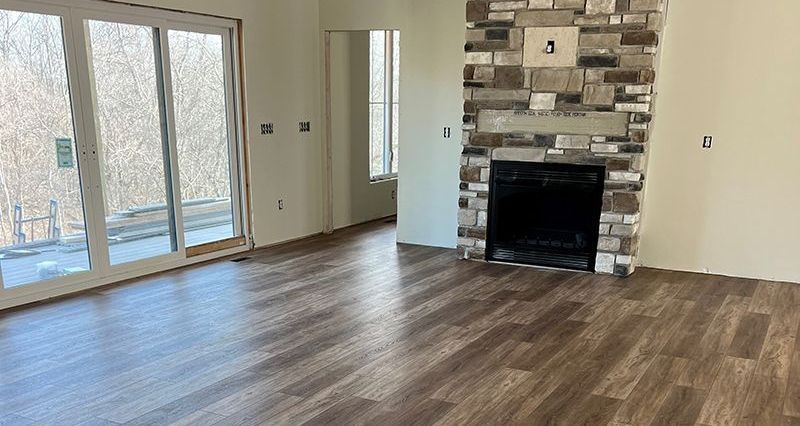How Laminate Flooring Is Installed and Why Hiring a Pro Makes All the Difference
Laminate flooring has become one of the most popular choices for homeowners in Cincinnati. It offers the look of hardwood at a fraction of the cost, is highly durable, and comes in a variety of styles to match any space. But before you start shopping for planks, many homeowners want to know: how laminate flooring is installed—and more importantly, whether it’s worth doing it yourself or calling in a professional.
In this blog, we’ll walk you through the steps of laminate flooring installation, compare the DIY process to professional installation, and explain how factors like cost, quality, and warranty affect your final decision.
How Laminate Flooring Is Installed: The Step-by-Step Process
One reason laminate flooring is so popular is its click-and-lock design, which makes installation easier than many other flooring types. Still, there are important steps to follow for a long-lasting result.
1. Subfloor Preparation: Every installation begins with prep. The subfloor must be clean, dry, and level. If the surface is uneven or damaged, repairs are required before laying down the laminate.
2. Underlayment Installation: Most laminate requires underlayment—a thin padding that helps with sound absorption, moisture protection, and comfort underfoot. Skipping this step can lead to noisy or uneven floors.
3. Measuring and Planning the Layout: Installers carefully measure the space, plan plank direction, and calculate how to stagger joints. Proper planning ensures the finished floor looks balanced and avoids awkward cuts along walls.
4. Installing the First Row: The first row of planks is the most important. If it isn’t perfectly straight, every row after will be affected. Spacers are used to maintain expansion gaps around the edges.
5. Click-and-Lock Installation: Planks are snapped together row by row. Precision matters—forcing planks can break the locking system, while gaps can create uneven seams.
6. Trimming and Fitting Around Obstacles: Cutting planks to fit around doorways, vents, and other obstacles takes skill and patience. Mistakes here can leave gaps or damage materials.
7. Installing the Final Row and Molding: The last row is carefully cut to fit, then baseboards or quarter-round trim are installed to cover expansion gaps.
When done correctly, laminate flooring looks seamless and lasts for years. But even with these steps laid out, the difference between a DIY job and professional installation can be dramatic.
DIY Laminate Flooring Installation
Many Cincinnati homeowners are drawn to laminate flooring because it seems like a manageable DIY project. And in some cases, it can be.
Pros of DIY:
- Lower upfront cost: You’re saving on labor.
- Personal satisfaction: For handy homeowners, tackling a project can be rewarding.
- Flexibility: Work at your own pace, on your own schedule.
Cons of DIY:
- Risk of mistakes: Misaligned planks, uneven seams, or skipped underlayment can ruin the look.
- Time-consuming: What might take a professional crew one day could take a homeowner an entire weekend—or longer.
- Tools and equipment: You may need to rent or buy tools like saws, spacers, and tapping blocks.
- No warranty: Most manufacturer warranties are voided if installation isn’t done by a certified installer.
DIY is best suited for very small projects or homeowners with experience in flooring installation. But for most people, the potential pitfalls outweigh the savings.
Professional Laminate Flooring Installation
When you hire a flooring contractor like Cincy Preferred Flooring, you get more than just someone to lay down planks—you get peace of mind.
Pros of Professional Installation:
- Expert Preparation: Professionals know how to check moisture levels, level the subfloor, and install underlayment correctly.
- Speed and efficiency: What could take a homeowner several days is usually completed in one day by a skilled crew.
- Precision fit: Pros have the tools and training to handle tricky cuts around stairs, doors, and vents.
- Warranty protection: Many laminate manufacturers require professional installation to maintain product warranties.
- Long-term durability: A properly installed floor is less likely to shift, squeak, or warp.
Cons of Professional Installation:
- Higher upfront cost: You’ll be paying for labor in addition to materials.
However, for most homeowners, the long-term value more than outweighs the initial expense.

Cost Comparison: DIY vs. Professional
Cost is often the deciding factor when homeowners ask whether to DIY or hire a pro. Here’s how it breaks down:
- DIY installation: You pay only for materials and tools. Laminate flooring ranges from $2 to $5 per square foot, and underlayment adds another $0.50 to $1 per square foot. Renting tools may cost another $50 to $150.
- Professional installation: In Cincinnati, professional laminate flooring installation typically costs between $2 $6 per square foot for labor, in addition to material costs.
At first glance, DIY looks cheaper. But factor in the cost of potential mistakes—like having to replace planks, uneven floors, or voided warranties—and professional installation often becomes the smarter financial decision.
Quality Considerations
The difference between a DIY and a professional job often comes down to quality.
- DIY challenges: Gaps between planks, uneven rows, squeaking floors, or damage to locking systems.
- Professional results: Seamless joints, perfectly aligned rows, and flooring that lasts longer with fewer issues.
For high-traffic areas like living rooms, kitchens, and basements, professional quality pays off.
Warranty Considerations
One of the biggest overlooked factors in laminate flooring installation is the warranty.
- DIY installation: If you install the floor yourself, you may void the manufacturer’s warranty, meaning you’re responsible for any defects, warping, or premature wear.
- Professional installation: Certified installers ensure the warranty remains valid, protecting your investment for years to come.
For homeowners seeking peace of mind, professional installation is the better choice.
When DIY Might Make Sense
That doesn’t mean DIY is never an option. If you’re installing laminate in a small space—like a single bedroom, home office, or walk-in closet—you might feel comfortable tackling the job yourself. Just be sure you’re prepared with the right tools, patience, and attention to detail.
Why Cincinnati Homeowners Choose Professional Installation
For larger projects, open floor plans, or homes with tricky layouts, most Cincinnati homeowners find that professional installation saves time, stress, and money in the long run. Plus, hiring a trusted local company like Cincy Preferred Flooring means you get:
- Experienced installers with decades of combined expertise
- Access to top-quality laminate products
- Free in-home estimates to help you plan your project
- Competitive pricing without hidden fees
- Guaranteed workmanship and warranty protection
The Final Word: DIY vs. Professional
So, how laminate flooring is installed depends on who’s doing the work. DIY can be tempting for small spaces and budget-conscious homeowners, but it comes with risks that can shorten the life of your floor and eliminate warranty protection.
Professional installation ensures your laminate is installed correctly, quickly, and with lasting results. While the upfront cost is higher, the long-term value makes it the smarter choice for most homeowners.
Ready to Install Laminate Flooring in Your Cincinnati Home?
At Cincy Preferred Flooring, we’ve helped countless homeowners transform their spaces with beautiful, durable laminate flooring. Whether you’re considering a DIY project or want to explore professional installation, our team can walk you through your options and provide a free, no-obligation estimate.
If you’ve been asking yourself how laminate flooring is installed, let us show you the difference professional installation can make. Contact us today to schedule your consultation and take the first step toward a stylish new floor.


